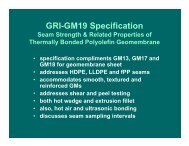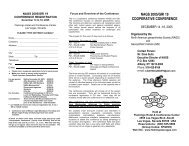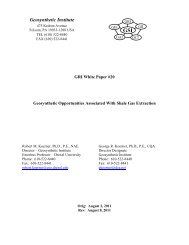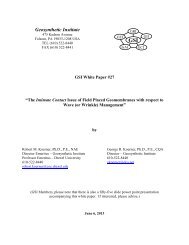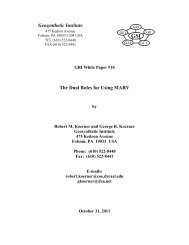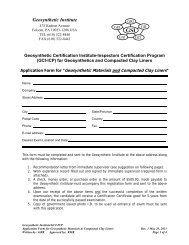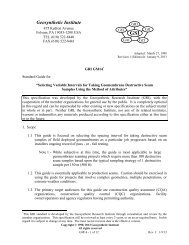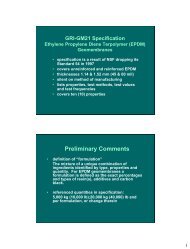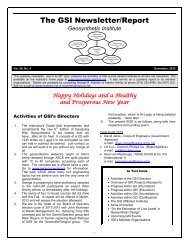GCL Design Guide - The Geosynthetic Institute
GCL Design Guide - The Geosynthetic Institute
GCL Design Guide - The Geosynthetic Institute
You also want an ePaper? Increase the reach of your titles
YUMPU automatically turns print PDFs into web optimized ePapers that Google loves.
8. <strong>GCL</strong> Strength Properties<br />
8.1 Wide-Width Tensile Strength—<strong>GCL</strong>’s, as a composite material, are occasionally<br />
placed under wide-width tensile stress conditions and must be evaluated<br />
accordingly. Steep short slopes of canals, ponds and secondary containment<br />
facilities are situations where the <strong>GCL</strong> is contained at the top of slope in an<br />
anchor trench and tensile stresses may be imposed along the length of the slope.<br />
Based on limit equilibrium there are several models available to determine the<br />
induced stresses which must be counterpointed against the <strong>GCL</strong>’s tensile strength<br />
as measured in ASTM D 6768. Reduction factors on the <strong>GCL</strong>’s ultimate strength<br />
are appropriate to apply; see GRI White Paper #4 (2005). <strong>The</strong> resulting factor-ofsafety<br />
is assessed by the designer upon consideration of the criticality and<br />
permeance of the situation.<br />
8.2 Internal Shear Strength—<strong>GCL</strong>s are commonly divided into reinforced and<br />
unreinforced types. <strong>The</strong> reinforced <strong>GCL</strong>s have fibers, threads or yarns that<br />
connect the upper and lower geotextiles that form the two exterior surfaces of the<br />
<strong>GCL</strong>. <strong>The</strong>refore, the internal shear strength of <strong>GCL</strong>s will be greatly influenced<br />
by the needled or stitched fibers that penetrate through the thickness of the <strong>GCL</strong>.<br />
In its hydrated state the bentonite itself will offer some, but very limited, shear<br />
strength by itself. <strong>The</strong>se various components provide an internal shear strength<br />
that can be impacted by the degree of hydration of the clay, the normal load acting<br />
on the <strong>GCL</strong>, the type and amount of fiber reinforcement and the shear strain that<br />
has occurred across the thickness of the <strong>GCL</strong>. Test Method D 6243 measures the<br />
simultaneous contribution of all of these internal shear strength components. That<br />
said, the cited test method is silent on the essential parameters necessary to<br />
properly perform the test. <strong>The</strong>se include, but are not limited to, normal stresses,<br />
saturation conditions, liquid type, consolidation time, shearing rate, shearing<br />
distance, etc. <strong>The</strong>se (and others) are site-specific conditions and are at the<br />
designer’s discretion. This section will elaborate on various aspects of internal<br />
shear strength.<br />
8.2.1 Bentonite Shear Strength—<strong>The</strong> clay, in particular, bentonite, that forms<br />
the hydraulic barrier component of <strong>GCL</strong>’s has a hydrated shear strength<br />
that is influenced by the degree of hydration and the normal loading. <strong>The</strong><br />
shear strength of hydrated clays has been evaluated by Olson (1974) who<br />
produced a series of effective stress failure envelopes. From Olson’s<br />
work, the lower limit of the effective shear strength of bentonite clay is<br />
approximately 35 kPa at a normal load of approximately 275 kPa. This<br />
shear strength can be increased by decreasing the percentage of bentonite<br />
in the clay but at a cost of increased permeability. At lower normal loads,<br />
the degree of hydration increases and the shear strength decreases to zero<br />
at no normal load. At somewhat higher normal loads, Daniel, et al. (1993)<br />
showed that the drained friction angle of the bentonite clay in <strong>GCL</strong>s<br />
approaches seven degrees. Data is not available at high and very high<br />
normal loads and site-specific testing is required for such sites.<br />
<strong>GCL</strong>5 - 12 of 34 Rev. 1: 1/9/13



